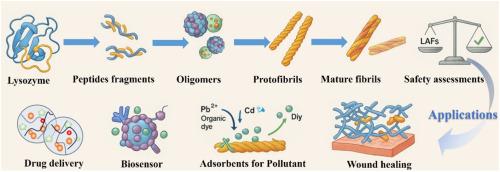溶菌酶淀粉样蛋白原纤维作为安全功能材料:从分子认识到功能应用
IF 11
1区 农林科学
Q1 CHEMISTRY, APPLIED
引用次数: 0
摘要
淀粉样原纤维,曾经是神经退行性病变的代名词,现在被重新设想为具有无与伦比的结构多样性的功能性生物材料。其中,溶菌酶淀粉样蛋白原纤维(LAFs)因其固有的安全性、可生物降解性和多功能性而成为营养应用的典范转移候选者。本文综述了LAFs的分层组装机制、安全性验证及其在材料科学(抗菌材料、水凝胶)、生物医学领域(营养输送)和环境修复(污染物吸附剂)中的新作用。通过综合多学科的知识,我们旨在提供这一新兴领域的整体观点,并强调溶菌酶淀粉样蛋白原纤维在食品和健康工业中的前景。LAFs作为营养、健康和环境可持续性方面紧迫挑战的创新解决方案的潜力强调了它们作为一类新型生物材料的重要性,为利用其独特特性的未来研究和应用铺平了道路。本文章由计算机程序翻译,如有差异,请以英文原文为准。

Lysozyme amyloid fibrils as safe functional materials: From molecular insights to functional applications
Amyloid fibrils, once synonymous with neurodegenerative pathologies, are now being reimagined as functional biomaterials with unparalleled structural versatility. Among these, lysozyme amyloid fibrils (LAFs) emerge as a paradigm-shifting candidate for nutritional applications due to their inherent safety, biodegradability, and multifunctionality. This review integrates recent advances in understanding LAFs' hierarchical assembly mechanisms, safety validation, and their emerging roles in materials science (antimicrobial materials, hydrogels), biomedical fields (nutrient delivery), and environmental remediation (pollutant adsorbents). By synthesizing knowledge from multiple disciplines, we aim to provide a holistic view of this emerging field and highlight the promising future of lysozyme amyloid fibrils in the food and health industries. The potential of LAFs to serve as innovative solutions for pressing challenges in nutrition, health, and environmental sustainability underscores their significance as a new class of biomaterials, paving the way for future research and applications that leverage their unique properties.
求助全文
通过发布文献求助,成功后即可免费获取论文全文。
去求助
来源期刊

Food Hydrocolloids
工程技术-食品科技
CiteScore
19.90
自引率
14.00%
发文量
871
审稿时长
37 days
期刊介绍:
Food Hydrocolloids publishes original and innovative research focused on the characterization, functional properties, and applications of hydrocolloid materials used in food products. These hydrocolloids, defined as polysaccharides and proteins of commercial importance, are added to control aspects such as texture, stability, rheology, and sensory properties. The research's primary emphasis should be on the hydrocolloids themselves, with thorough descriptions of their source, nature, and physicochemical characteristics. Manuscripts are expected to clearly outline specific aims and objectives, include a fundamental discussion of research findings at the molecular level, and address the significance of the results. Studies on hydrocolloids in complex formulations should concentrate on their overall properties and mechanisms of action, while simple formulation development studies may not be considered for publication.
The main areas of interest are:
-Chemical and physicochemical characterisation
Thermal properties including glass transitions and conformational changes-
Rheological properties including viscosity, viscoelastic properties and gelation behaviour-
The influence on organoleptic properties-
Interfacial properties including stabilisation of dispersions, emulsions and foams-
Film forming properties with application to edible films and active packaging-
Encapsulation and controlled release of active compounds-
The influence on health including their role as dietary fibre-
Manipulation of hydrocolloid structure and functionality through chemical, biochemical and physical processes-
New hydrocolloids and hydrocolloid sources of commercial potential.
The Journal also publishes Review articles that provide an overview of the latest developments in topics of specific interest to researchers in this field of activity.
 求助内容:
求助内容: 应助结果提醒方式:
应助结果提醒方式:


